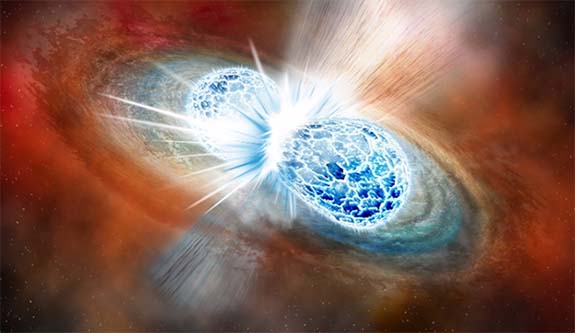Thousands of astronomers from around the globe joined together on Monday to confirm the first-ever sighting of two neutron stars colliding in space. In just one second, the "kilonova" generated the equivalent of 50 Earth masses of silver, 100 Earth masses of gold and 500 Earth masses of platinum.
The gold alone is estimated to be worth more than $100 octillion. That's $100,000,000,000,000,000,000,000,000,000 (1 followed by 29 zeroes).
The collision, which was detected on August 17, settles the long-standing mystery of how rare precious metals and other “heavy” elements are formed.
“We already knew that iron came from a stellar explosion, the calcium in your bones came from stars, and now we know the gold in your wedding ring came from merging neutron stars,” University of California Santa Cruz’s Ryan Foley told the Associated Press.
Scientists described a scenario in which two ultra-dense neutron stars spiral around each other, moving closer and closer, until they eventually merge in a violent eruption. The material blasted into space contains a variety of heavy elements that are formed through a chain of nuclear reactions know as the "r-process."
After the first detection, astronomers from around the world were alerted and each of them pointed telescopes at the scene to record the visible light, radio waves, X-rays and gamma rays. Their equipment identified massive amounts of platinum, gold and silver.
"You smash these two things together at one-third the speed of light, and that's how you make gold," Duncan Brown, an astronomer at Syracuse University and a member of the research collaboration, told Business Insider.
The smashup took place 130 million light-years from Earth in the constellation Hydra.
Scientists had postulated for years that precious metals were likely forged by the clash of neutron stars, which are the ultra-dense cores of aged stars. A single teaspoon of this neutron-rich material is estimated to weigh roughly one billion tons.
In the two months following the neutron star collision, astronomers from around the world teamed up to make sense of the event, which some have called the "discovery of the century." The resulting research study lists 4,000 authors representing 910 institutions.
Scientists believe that neutron star mergers in our galaxy take place about once every 100,000 years. Because astronomers worldwide are listening to millions of galaxies, they expect to identify a few spectacular collisions per year.
Credit: Image by Robin Dienel/Carnegie Institution for Science.















